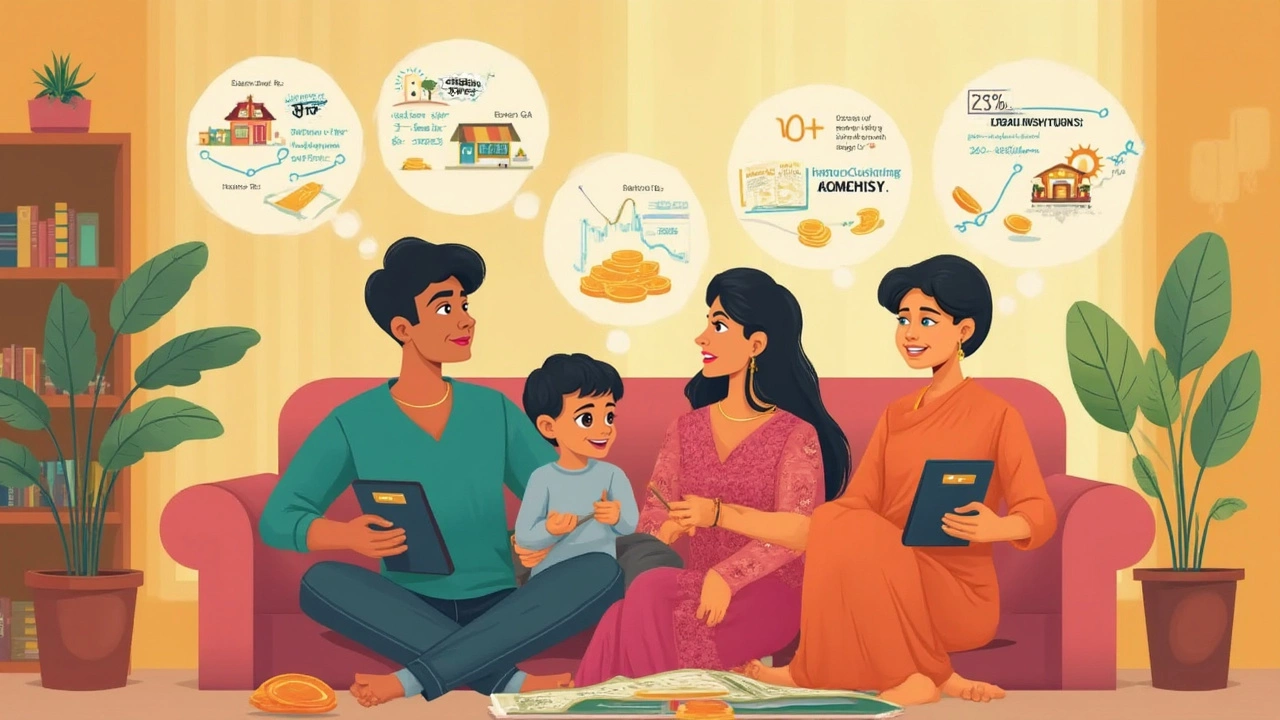
Want to snag a 12 percent return just by plopping your cash into a savings account? Bad news—no U.S. bank is offering anywhere close. The highest high-yield savings rates as of mid-2025 are hovering between 4.5 and 5.1% if you’re lucky. So if some app or website is dangling numbers near 12%, that’s a massive red flag. Traditional savings accounts are safe, FDIC-insured, and reliable, but they aren't your ticket to double-digit growth.
Hitting that 12% number usually means stepping outside comfort zones—think stocks, real estate, or maybe peer-to-peer lending if you like excitement (and risk). Compounding makes a huge difference, so if you're chasing those returns, you have to play smarter, not just harder. It's not about gambling on meme stocks or trusting flashy online ads. It’s understanding what moves the needle and knowing where things can go sideways fast.
If you ever see a savings product promising 12% APY, hit pause. FDIC-insured banks aren’t in that business; most wild claims come from platforms with zero safety net. There are legit ways to aim higher, but you can’t skip the fine print or ignore the swings. It’s a financial jungle out there, so stick around for the real facts before throwing your savings at the first shiny promise.
- Why You Won't Find 12% APY in a Savings Account
- What Really Gets You Double-Digit Returns
- Risks and Trade-Offs: What They Don’t Tell You
- Smart Strategies for Chasing High Yields
Why You Won't Find 12% APY in a Savings Account
If you’ve spent any time comparing savings products, you already know that banks just aren’t offering anything close to a 12% APY. Back in the 1980s, interest rates on savings were wild—people used to see double digits thanks to crazy inflation, but that ship has sailed for decades now. These days, even the flashiest "high-yield" accounts top out around 5%, and that’s during a period of historic rate hikes from the Federal Reserve.
Banks can’t pay more than they earn from loans and investments. Most of their money comes from mortgages, car loans, and credit cards. With average 30-year mortgage rates floating around 7% in 2025, and banks needing to cover operating costs and make profits, there’s simply no room to shell out double-digit returns to account holders.
Let’s look at real numbers. Here’s how actual savings account rates stack up:
| Bank Name | APY (%) |
|---|---|
| Ally Bank | 4.25 |
| Synchrony | 4.75 |
| Marcus by Goldman Sachs | 4.40 |
| American Express | 4.35 |
| Best Ever (2025 average) | 5.10 |
Notice none of those come even halfway to a 12 percent return. If someone says otherwise, they're either running a scam or they're not talking about a regular savings account.
"The safety that comes with FDIC insurance is traded off for lower yields. You just aren't going to see a standard 12 percent return in insured U.S. savings products." — Greg McBride, Chief Financial Analyst at Bankrate
Here’s what a normal savings account gets you:
- FDIC insurance up to $250,000 per depositor, per bank
- Zero risk of losing your initial deposit unless the world totally collapses
- Consistent liquidity — take your money out anytime
- The trade-off: nothing near double-digit returns
Spotting the impossible in personal finance is crucial. Anyone pitching ultra-high yields for insured U.S. accounts is either misleading you or missing a pile of fine print (and hidden risk).
What Really Gets You Double-Digit Returns
If you're gunning for a 12 percent return, forget about stashing cash in regular savings accounts. That level of return is almost always tied to investments with more risk than your average bank product. Let's break down what actually gets people into double-digit territory and what the stats say about each option.
Most folks see 12% or better from these sources:
- Stock Market Index Funds: Historically, the S&P 500 has averaged around 10-11% per year if you reinvest dividends and stay in the game for decades, not months. Picking individual stocks? Sometimes you win big, but usually it's more luck than skill unless you do some serious homework.
- Real Estate Investing: Buying, renovating, and flipping homes can hit double digits in hot markets, but it takes work and upfront cash. Rental properties in the right city sometimes get you 10%+ cash-on-cash returns, especially if you leverage your money smartly.
- Peer-to-Peer Lending and Crowdfunding: You lend money to strangers or small businesses online. Platforms sometimes claim 10-12% annual returns, but defaults happen and your losses aren’t FDIC-insured. It’s a high-wire act.
- Private Equity & Startups: Angel investing and joining small business ventures can shoot way past 12%—or crash completely. Most regular people can’t access these markets easily, and the risks are huge.
- REITs (Real Estate Investment Trusts): These are stocks that pool money into real estate. Public REITs on average deliver 8-12% if the market's strong, but payouts jump around with the economy.
Here's a snapshot of average annual returns for some popular options over the past 20 years:
| Investment | Average Annual Return (%) |
|---|---|
| S&P 500 Index Fund | ~10.4 |
| Direct Real Estate (U.S.) | 8-12 (varies a lot) |
| Peer-to-Peer Lending | 4-10 (after defaults) |
| Public REITs | 8-12 |
| High-Yield Savings Accounts | 4.5-5.1 |
Real talk: hitting a 12% return means juggling more risk, dealing with more effort, or both. If you're cool with market ups and downs, index funds and REITs can get close over the long haul. If you need steady, safe money, that kind of return just isn't realistic.

Risks and Trade-Offs: What They Don’t Tell You
Everybody loves the idea of earning double-digits, but hardly anyone talks about the real price tag: risk. You don’t get a 12 percent return without accepting that the ride might get bumpy—or even bloody—in the short term. Here’s what you’re often not told upfront.
Let’s break down where those risks really show up:
- No Guarantees: Stocks can drop fast. In 2022, the S&P 500 lost about 19%. That was a tough pill for anyone counting on a smooth path.
- Market Timing: Trying to jump in and out of investments for that magic return usually backfires. History shows very few, even so-called experts, get timing right for long.
- Hidden Fees: Some high-yield funds can eat up your profits with eye-watering management fees or sneaky costs.
- Illiquidity: Investments like real estate and private loans might offer high returns, but you can’t just cash out whenever you want—there's always a lock-up or a long wait period.
- Psychology: It gets ugly when markets tank. Lots of investors bail out at the worst moment because it just feels safer, locking in real losses.
Here’s a look at what can happen with different investments aiming for high returns. Check out how wild those swings can get:
| Investment | Average Annual Return | Worst Year (%) | Liquidity | Ease of Access |
|---|---|---|---|---|
| S&P 500 Index | 10-12% | -38% (2008) | High | Simple |
| REITs (Real Estate Investment Trusts) | 9-11% | -37% (2008) | High | Simple |
| Peer-to-Peer Lending | 6-10% | -100% (Defaults) | Low | Moderate |
| Crypto Assets | 20-200% (wild years) | -80%+ | High | Simple |
| High-Yield Savings | 4-5% | 0% | High | Simple |
High returns tend to show up where risks and volatility run high. Remember, nobody hands out outsized gains without expecting you to take on some pain. Make sure you’re not betting money you can’t afford to lose or tie up for a few years.
Smart Strategies for Chasing High Yields
If you’re serious about hitting a 12 percent return on your money, you need a solid plan—and nerves of steel. The reality: double-digit returns come with bigger risks, so you want to manage those risks and avoid betting the farm. Here’s what actually works for folks willing to roll up their sleeves.
- Index Funds and ETFs: Over the last 50 years, the S&P 500 averaged around 10% per year (with dividends reinvested). Some years crush 12%, but you have to hang tight for the long haul and ride out ugly downturns. Index funds are a favorite because they spread the risk and still deliver solid growth.
- Real Estate Investing: People who invest smartly in rental properties or REITs (real estate investment trusts) can see annualized returns edging close to or above 12%, especially after factoring in rental income and property appreciation. But it takes upfront cash, patience, and homework on your market.
- P2P Lending: Lenders on platforms like Prosper or LendingClub sometimes report annual returns near or above 12%, but defaults can eat up interest gains fast. Only put in what you’re prepared to lose and diversify across lots of smaller loans.
- Active Stock Picking: It can work if you have the time and stomach for volatility. Some individual stocks smoke the market—think of Amazon’s crazy growth or Tesla’s run—but many more fall flat or worse. Only risk what won’t keep you up at night.
Here’s how different options have performed in recent years:
| Investment Type | Average Annual Return (2013-2023) | FDIC Insured? |
|---|---|---|
| S&P 500 Index Fund | ~12.0% | No |
| REITs | ~8-12% | No |
| High-Yield Savings | ~2.5% | Yes |
| P2P Lending (top quintile) | ~7-12% | No |
A few practical tips before you jump in:
- Spread your money across several investments. Don’t bank on one hot pick to save the day.
- Pick low-fee index funds if you want a steady hand in the market. High fees zap your gains over time.
- Reinvest dividends and interest automatically. Compounding works better when you don’t touch the earnings.
- Keep an eye on taxes. Tax-advantaged accounts like Roth IRAs or HSAs protect your returns from Uncle Sam’s cut.
- Double check for scams before using any new platform or app. If the yield sounds bonkers, it probably is.
The right strategy is the one you actually stick with. Earning 12% is possible, but it’s never guaranteed, so keep your eyes open and your risks managed.







Write a comment